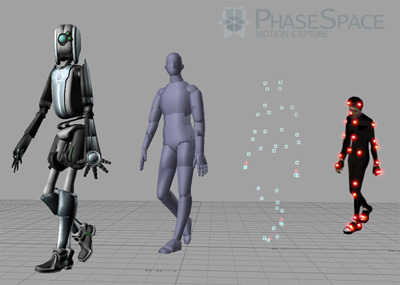In performance capture, actors wear the same body suits as in motion capture, but also record the facial movements using either special makeup to enhance the contrast of the face, or reflective markers or LEDs. Markerless systems that track the facial features are being developed but currently suffer from resolution issues that make them difficult to use at camera distances that allow full body motion capture. The actor usually interacts with wireframe models of the objects in the scene. The recorded performance data can be used to animate different actors. In The Polar Express Tom Hanks played five roles - an 8-year old boy, his father, the train's conductor, a hobo, and Santa Claus.
Using Alias Motion Builder software, low polygon count (Low being subjective, a few 10,000 polygons verses millions for film quality characters) can be animated in real time to allow characters to be viewed in real time in digital sets. This unique capability allows Performance capture to create real time animatics. It is expected that the success of animatics in Lucas Films "Star Wars" and other projects will eventually lead to an entire industry segment where all movies will be previsualized before they are greenlighted.
 PhaseSpace 480 hertz 3,600 x 3,600 resolution
System.
PhaseSpace 480 hertz 3,600 x 3,600 resolution
System.
Newer active marker systems such as PhaseSpace [1] modulate the active output of the LED to differentiate each marker, allowing several markers to be on at the same time, while still providing the higher resolution of 3,600 x 3,600 or 12 megapixel resolution while capturing at 120 (128 markers or four persons) to 480 (32 markers or single person) frames per second. The advantage of using active markers is intelligent processing allows higher speed and higher resolution at a lower price. This higher accuracy and resolution requires more processing than older passive technologies, but the additional processing is done at the camera to improve resolution via a subpixel or centroid processing, providing both high resolution and high speed. By using newer processing and technology, these motion capture systems are about 1/3 the cost of passive systems. The key advantage besides higher resolution and data quality is low latency for Performance capture. Additionally the active markers reduce data cleanup times by a factor of ten over older technologies.
Note this active marker system can be used with facial expressions, but requires patience by the actor to wear LEDs on the face, and most facial capture systems require exaggerated expressions. Fingers pose a problem with most optical motion capture systems and require data gloves, or controllers to differentiate hand positions when the hands are often blocked from cameras.
Although performance capture has been used in some earlier films and computer games, The Polar Express was the first movie made solely with the process. This film was directed by Robert Zemeckis, who had a long history of technical innovations in filmmaking (historical composites in Forrest Gump and the combination of animation and live action in Who Framed Roger Rabbit) and became a self-professed fan of performance capture (he produced the 2006 thriller Monster House made using the same technique) because of the creative freedom it gives the director. Zemeckis is currently using performance capture in an adaptation of Beowulf scheduled for 2007 release.
Most recently, Titanic director James Cameron has been given permission to lease the performance capture technology to bring to life the numerous monsters and cyborg characters in his next theatrical motion picture Battle Angel Alita. Cameron explains that the film's main star, Alita, a young cyborg girl, will be completely computer generated, using performance capture.
Often cited as "performance capture" is the Lord of the Rings character Gollum. There is some dispute on this subject. There have been many publicity stills showing Andy Serkis in a motion capture suit, with dots on his face; however, many scenes were keyframe animated at Weta Digital using Serkis's performance as a reference. Artists would animate on top of film plates of Serkis, using the human eye instead of the computer to capture the subtleties of his performance in an effective but time-consuming process. This method is often referred to as "rotomation," and is a CGI form of the traditional animation technique called rotoscoping. Serkis did this again to play the title character in King Kong (2005).
Another example is the character of Sonny in I, Robot (film), played by Alan Tudyk.
External links
- Performance Capture and Optical Motion Capture - Active Marker LED based real time motion tracking hardware and software for VR, AR, Telerobotics, medical and entertainment applications.




 216.73.216.81
216.73.216.81 User Stats:
User Stats:
 Today: 0
Today: 0 Yesterday: 0
Yesterday: 0 This Month: 0
This Month: 0 This Year: 0
This Year: 0 Total Users: 117
Total Users: 117 New Members:
New Members:
 216.73.xxx.xx
216.73.xxx.xx
 Server Time:
Server Time: